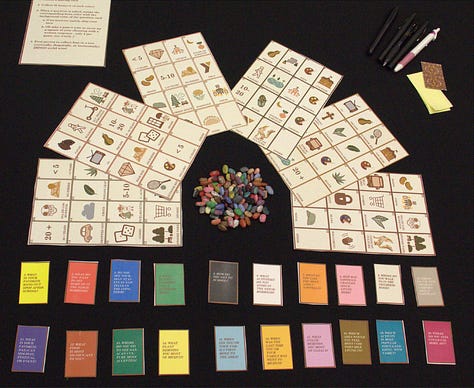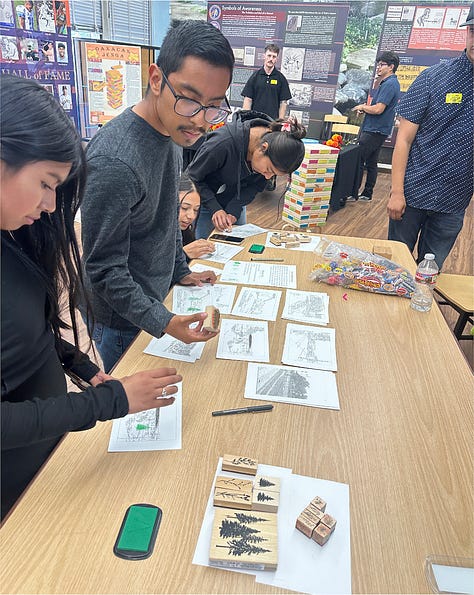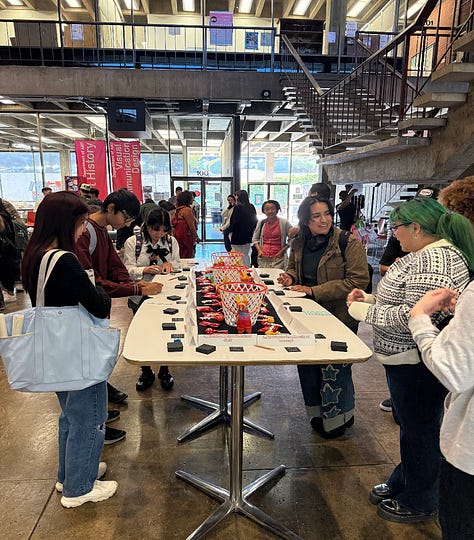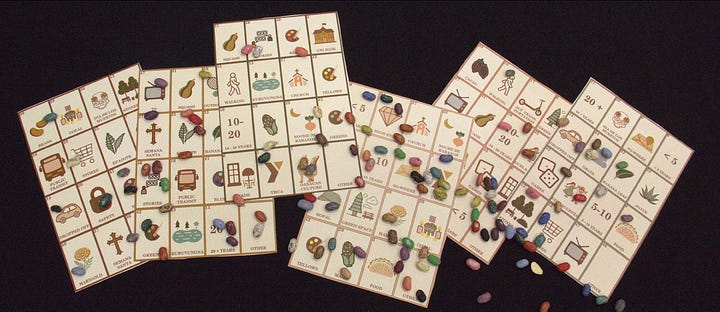A List of Books: Community Engagement
Ideas that changed how I think about, engage with, and practice ‘community engagement’
Community engagement is more than a buzzword; it's the bedrock of resilient neighborhoods, effective partnerships (whether it’s non-profit or public-private partnerships), and genuine democracy. In the early parts of my career as a landscape architect, I helped create content and facilitate community workshops for design projects. I learned what tokenism (for better or worse) looked like in real-life settings; and after working on projects that saw no real effective change in the built environment, I began to wonder about other methods for getting in touch with people at the local level to talk about ‘change’. I wondered about all the people we weren’t reaching – elders, parents of school-aged youth, and youth themselves!
I started to ask “But what does it actually look like? How do we move from tokenistic consultation to true community ownership and collaboration?” The process of engagement is multifaceted, ranging from grassroots organizing and asset-based development to strategic facilitation and digital community-building (and so much more that I haven’t even brushed the surface of; please forgive).
Much of my work is powered by community engagement methods and processes. After years of practicing in different settings, I developed a knack for developing creative activities that combine design with dialogue about change. None of us love change, but it’s inevitable. This way of knowing how to design is embedded in my practice and teaching.
This list of books offers a brief journey through some foundational philosophies, practical "how-to" guides, and critical perspectives that have transformed my understanding and practice of community engagement work.





0. Ladder of Citizen Participation
by Sherry Arnstein
Arnstein’s seminal essay outlines the different levels of public involvement, from "Manipulation" and "Therapy" at the bottom to "Citizen Control" at the top. It provides a stark and enduringly relevant vocabulary for diagnosing the true level of power communities have in any given process. Download an essential article HERE to learn more about the Ladder of Citizen Participation.
1. Bowling Alone: The Collapse and Revival of American Community
by Robert D. Putnam
This is seminal work on the concept of "social capital." Putnam meticulously documents the decline of civic and social life in America over the last several decades and argues why rebuilding these connections is vital for our health, democracy, and economy. While the data is from the late 20th century, the diagnosis is more relevant than ever. It provides the crucial "why" behind community engagement efforts and will give you a deep appreciation for the value of clubs, associations, and informal social ties.
2. The Art of Gathering: How We Meet and Why It Matters
by Priya Parker
Every form of engagement involves a "gathering," whether it's a town hall, a committee meeting, or a block party. Parker, a master facilitator, deconstructs what makes gatherings transformative versus forgettable.
This book provides actionable advice on how to define a gathering's purpose, use rules and etiquette to shape behavior, and create memorable, meaningful experiences. It's a game-changer for anyone who runs meetings.
by Paulo Freire
A foundational text in critical pedagogy and social justice, Freire's work is essential for understanding the power dynamics inherent in any engagement process. He critiques the "banking model" of education (and by extension, engagement) where an "expert" deposits information into passive recipients.
You'll be introduced to concepts like "conscientization" and problem-posing dialogue. This book will challenge you to see engagement as a tool for liberation and mutual learning, ensuring that community members, students, and clients are active subjects in their own story, not passive objects of your help.
4. The Art of Community: Seven Principles for Belonging
by Charles H. Vogl
Vogl draws on centuries of tradition from spiritual and tribal communities to distill seven core principles for building authentic community in any context—from a start-up to a neighborhood association.
Here is a brief glimpse into the seven principles:
The Boundary Principle: Communities need a clear line between members and outsiders. This isn't about being exclusionary for its own sake, but about creating a safe and trusted space for members to connect. Knowing who is "in" allows for vulnerability and the development of shared identity.
The Initiation Principle: There must be a recognizable moment or process for joining the community. An initiation, whether a formal ceremony or an informal welcome, confirms to both the new member and the group that they now belong. It resolves the newcomer's "crisis of belonging" and solidifies their place.
The Rituals Principle: Communities are strengthened by shared, meaningful activities. Rituals are the things a group does together that have a purpose beyond the action itself. They can be formal (like an annual meeting or celebration) or informal (like a weekly coffee meetup), but they build connection and reinforce shared values through repeated practice.
The Temple Principle: A community needs a special place to gather. This "temple" doesn't have to be a physical building; it can be a specific park bench, a dedicated online forum, or a regular video call. What matters is that it's a place that members identify as their own—a space set aside for the community to connect and find each other.
The Stories Principle: The stories a community tells are its living memory and a primary way of communicating values. This includes the origin story of the community, as well as the personal stories of its members. Sharing these narratives allows people to understand the group's purpose and to see themselves and their values reflected in others.
The Symbols Principle: Communities use symbols to represent important ideas and create a visible sense of identity. Symbols can be anything from logos and special clothing to inside jokes and unique jargon. They are visual or verbal shortcuts that remind members of their connection and what the community stands for.
The Inner Rings Principle: For a community to remain vibrant, members need a path to grow and deepen their involvement over time. The concept of "Inner Rings" describes levels of increasing participation and responsibility. This structure allows new members to join easily while giving dedicated members opportunities for leadership, mentorship, and greater influence, which keeps them engaged.
This is a clear, concise, and inspiring guide. You'll learn the importance of boundaries, rituals, stories, and other tangible elements that foster a deep sense of belonging and trust.
5. Dream Play Build: Hands-On Community Engagement for Enduring Spaces and Places
by James Rojas and John Kamp
This book is a direct challenge to the traditional, often ineffective, public meeting. Rojas and Kamp argue that the typical "planner-as-expert" model stifles creativity and leads to conflict. Instead, they champion a hands-on, playful, and art-based approach to community engagement that unlocks genuine collaboration and surfaces ideas that would otherwise remain hidden.
The core of the book is the "Place It!" methodology, which uses interactive model-building workshops with everyday objects (like pipe cleaners, buttons, and blocks) to help people express their memories, feelings, and dreams for a place. This tactile process bypasses the limitations of language and technical jargon, making it accessible to everyone, regardless of age, language, or background. You'll learn how to use this and other methods, like pop-ups and sensory site exploration, to create a more inclusive, fun, and ultimately more effective engagement process. The book is filled with practical advice and inspiring case studies that show how this approach can transform community planning.
6. Design as Democracy: Techniques for Collective Creativity
by David de la Peña, Diane Jones Allen, Randolph T. Hester, Jr., et al.
This book is an essential, modern-day playbook for anyone who wants to put the principles of community engagement into practice. It directly answers the question, "We believe in community-led design, but what do we actually do?" It argues that for places to be truly successful and equitable, the design process itself must be democratic, shifting power from a single expert to the collective creativity of the community.
This is not a book you read cover-to-cover; it's a toolkit you use. It presents over 30 hands-on techniques for engaging communities in the design and planning of their environment. Each technique is presented as a recipe with clear, step-by-step instructions, lists of required materials, time estimates, and advice on the best context to use it. The methods range from classics like community asset mapping and participatory model-making to more innovative approaches like photovoice, DIY urbanism, and pop-up demonstrations. Grounded in real-world case studies, the book provides a rich and incredibly practical guide for planners, architects, students, and community activists who want to facilitate a truly collaborative process that leads to more just and beloved public spaces.
--
I’m a lifelong learner! Are there books, resources, or podcasts that have inspired you surrounding this topic? Feel free to share your library.


